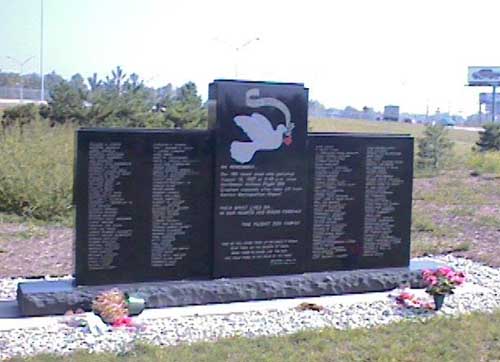Unthinkable tragedy over our skies

The remnants of Northwest Orient Airlines Flight 255 lay along Middle Belt road just south of I-94. There were 148 deaths — and one miraculous survivor. (Courtesy theintell.com)
Downriver’s most notable tragedy in history occurred on August 16, 1987, at 8:46 p.m., as Northwest Orient Airlines Flight #255, originating in Saginaw with a final destination in Orange County, Calfornia, crashed shortly after takeoff, killing all crewmembers and 148 of 149 boarded passengers. As of 2016, it ranks as the fourth deadliest aviation crash in United States history, and the fourth deadliest for the McDonnell Douglas MD-80 aircraft line.
Captain John R. Maus was the pilot and David J. Dodds the first officer of the aircraft: a McDonnell Douglas MD-82, tail N312RC, which began its flight at Tri-City Airport in Saginaw. Its itinerary included stops at Detroit Metro Airport (DTW) and Sky Harbor Airport in Phoenix, Arizona, before its final scheduled destination: John Wayne Airport in Orange County. The pilots were experienced, tallying 29,003 flight hours in 40 years of experience with the recently-merged Northwest Orient Airlines and Republic Airlines whose new hub (as Northwest Airlines) operated out of the J.M. Davey Terminal at Metro Airport.
Trajectory, path, and crash
The flight path of Flight 255.
Flight 255 carried 149 passengers and six crew members. The jet was manufactured in 1981, entering service as a Republic Aircraft. Takeoff initiated on Runway 3C at approximately 8:45 PM with a speed of 170 knots / 195 MPH. It began to roll side to side when elevated 50 feet above the ground. The aircraft then went into a stall, rotating 40 degrees to its left when it struck a light pole near the end of the runway, severing a portion of its left wing while igniting jet fuel. Rotating to the left an additional 90 degrees, it struck the southeastern corner of the Avis Car Rental building. With no controls available to the pilots, the aircraft crashed in an inverted form along Middle Belt Road, affecting vehicles traveling just south at the Wick Road intersection. Upon contact, the aircraft broke apart and burst into flame while making contact with the railway viaduct just north, as well as the viaduct carrying I-94 over Middle Belt Road.
This would be the first major aircraft disaster at Detroit Metropolitan Airport since its commission in 1927. Records show the most recent fatal incident occurred earlier that year, on March 4, involving a Northwest Orient Airlink aircraft, which had resulted in nine casualties.
The cockpit voice recorder (aka “black box”) provided evidence that the pre-flight taxi checklist was omitted. This would have determined if there were problems with the wing flaps and slats; they were not extended properly for smooth takeoff. An unknown factor was the cause of electrical failure within the takeoff warning system, which would had alerted the crew to the difficulty. Separate from this was also the unexplained reasoning for electrical failure onboard the Central Aural Warning System. This would later be answered by the failure of a P-40 circuit breaker; however, the actual cause still could not be determined (possibilities included tripping of the breaker, intentional opening of the circuit, or a question if electric current had flowed through the circuit at all). These determinations were confirmed by the National Transportation Safety Board.
| Technical Flight Synopsis — WING FLAPS: The DC-9`s wing flaps and slats were not used during takeoff, dooming the flight from the start.– CHECKLIST: There is a discrepancy between the airline and a federal panel over the cockpit voice recordings. Northwest Airlines officials say the two pilots mentioned the flaps during their pre-flight check. Federal investigators say they did not.– WARNING SYSTEM: The issue of whether the pilots were warned that they had failed to extend the flaps and slats remained unresolved at the hearings… Cockpit recordings made no mention of a warning going off. The warning system is protected by a circuit breaker.– EQUIPMENT FAILURE: Investigators failed to find any defects in the circuit breaker or related parts, but the plane`s manufacturer alerted airlines several years ago to problems with that system.– FINAL MOMENTS: The pilots are heard laughing as they prepare to take off. Right after one pilot said the plane had left the ground, engine stall warnings sounded. The last sound was a pilot`s brief curse. SOURCE: The Chicago Tribune The memorial commemorating Flight 255, located on the north side of Middlebelt between the railroad viaduct and I-94. A total of 154 Blue Spruce Trees, one marking each casualty, are partially seen beyond the marker. Memorials and Observances The granite memorial, pictured above, was erected in 1994. In its design is a dove with a ribbon in its beak, reading “Their spirit still lives on.”  On August 16, 2007, the twentieth anniversary of the crash, a memorial service was held at the site. For some people affected by the incident, it was their first return to the site since the crash.On August 16, 2012 (the 25th anniversary of the crash), a memorial service was again held at the crash site. Family and friends of the victims and others from across the Metro Detroit area (including local media) attended, and a local priest read each victim’s name aloud. Many attendees had seen recent local-media footage of Cecelia Cichan Crocker (the only survivor), and few knew her whereabouts or condition after the crash (see sidebar). | Cecelia: The Lone Survivor  Four-year old Cecelia Cichan, the only survivor of Flight 255, is shown at the hospital days after the crash. Ceceila and her family resided in Tempe, Arizona, at the time of the incident, and was presumably visiting friends or family in Saginaw, which routed them onto Flight 255. She was found buckled up in her seat several rows away from her parents and brother. Other than the photo above with reports that surgeries were successful, she would remain shielded from the public eye for almost 25 years, having moved to Alabama shortly after the crash. Having married, Ceceila Crocker broke her silence upon the 25th anniversary of the plane crash. In an interview shown on WDIV/News 4 for a project titled “Sole Survivor,” here were some of her thoughts about that day: “I think about the accident every day. It’s kind of hard not to think about it when I look in the mirror,.. I have visual scars. My arms and my legs. And I have a scar on my forehead.” Ceceila Crocker in 2011. In recent years, Ceceila began wearing a tattoo of an aircraft on her right wrist, telling the interviewer (Ky Dickens) she was coming to grips with what happened: “I got this tattoo as a reminder of where I’ve come from. I see it as — so many scars were put on my body against my will — and I decided to put this on my body for myself…” Continuing on, Ceceila reflected on her thoughts of the crash as it affected her life: “When I realized I was the only person to survive that plane crash, I was maybe in middle school, high school, maybe, being an adolescent and confused. So it was just extra stress for me. I remember feeling angry and survivor’s guilt. ‘Why didn’t my brother survive? Why didn’t anybody? Why me?'” Through the interview with Mr. Dickens, which took place near New York City in 2011, Ceceila mentioned that she does fly onboard as a passenger, and that the experience itself does not strike fear: “Flying doesn’t scare me. I have this mentality where if something bad happened to me once on a plane, it’s not going to happen again. The odds are just astronomical.” 25th anniversary commemoration of the flight 255 disaster held on site. (Courtesy clickondetroit.com) heinz cruisin history |